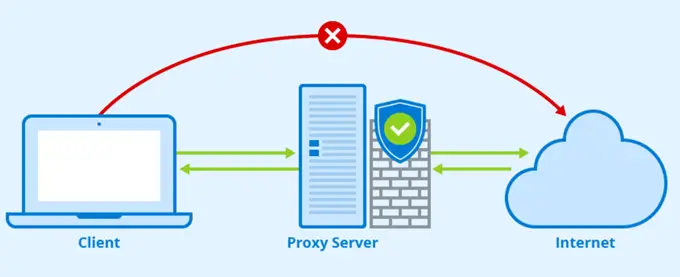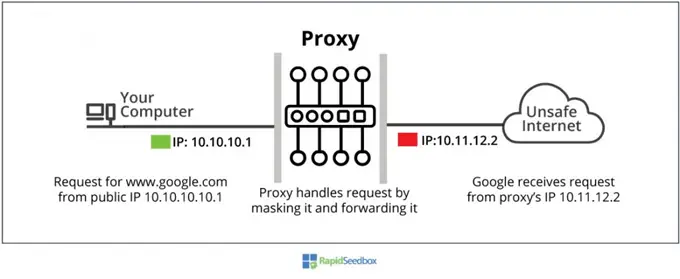Click here to get this post in PDF
If you browse the Internet daily and need some anonymity, an HTTP Proxy is for you. But also, if you have a website and provide content, an HTTP proxy can be very beneficial. HTTP proxies can hide HTTP requests from their source. But they can also act as traffic filters, to protect public web servers within internal networks.
In this post, we’ll go through the technical definition of an HTTP proxy, its types, and its advantages.
1. What is an HTTP Proxy?
A proxy server is an intermediary between a client located on a network and a server (or group of servers) on another network. Proxies intercept traffic, redirect it, and perform other functions such as filtering, and compressing.
The HTTP Proxy is designed to intercept all HTTP traffic from a client and redirect HTTP requests to a particular HTTP server. Once the HTTP proxy receives a response from the server, it will immediately forward it to the client.
- From the client’s point of view, it looks as if the original response came from the HTTP proxy.
- And from the server’s point of view, it appears as the original request came from the HTTP proxy.

The traffic flowing in and out of an HTTP proxy.
The HTTP Proxy can be beneficial for different types of traffic flows.
- The Inbound HTTP traffic is the internal-generated traffic (either a local internal network or a server on the Internet), flowing towards the HTTP proxy.
- The Outbound HTTP traffic is flowing away from the HTTP proxy. It is going towards a destination (either Internet server, or client’s computer).
There are various advantages for placing an HTTP proxy to protect traffic (either outbound or inbound). For example, your source traffic is protected by a proxy. Although you initiated the connection and sent outbound traffic, the HTTP proxy will receive it and forward it, as its own outbound. The traffic is now going away from the proxy towards a destination, which only sees inbound traffic from the proxy.
Additionally, the HTTP proxy can also help with traffic flowing inwards to your machine (or server). When someone else outside of your “server’s network” initiates a connection to your web server (such as an HTTP request), the HTTP proxy serves as the first layer of protection (i.e., traffic filtering).
2. Advantages of HTTP Proxy.
There is a large variety of types of proxies for different scenarios and applications. But HTTP proxy understands the HTTP protocol like no other proxy.
The HTTP proxy applications will vary according to different factors, including geography, traffic flows, and anonymity level. For example, an application can be different if a proxy is deployed closer to a source or a destination. Also, they will change, whether you intend to protect your external or internal traffic.
HTTP proxies can be considered either reverse or forwarding. The reverse HTTP proxy sits closer to where web servers are located and is intended to “filter traffic” flowing towards websites or HTTP servers. The forwarding HTTP proxy, on the other hand, is not intended to filter traffic only to forward and provide anonymity.
2.1. Improve the Performance and Reliability of a Website or Web Service.
The HTTP proxy can be configured as a load balancer. A website or service that gets a massive number of visits, might not be able to handle such traffic only from the origin server. The website needs a web server pool (also called Content Delivery Network) to help handle the load of the single website. An HTTP reverse proxy can intelligently redirect requests to different HTTP servers and balance their loads. This can also be useful for slowing down DDoS attacks.
An HTTP reverse proxy can also be used to cache website content to improve the website’s performance. This helps clients located far away from the origin server connect to a nearby HTTP proxy and load the cached content, resulting in much lower latency and higher performance.
2.2 Anonymous Web Browsing.
The HTTP proxy which is also referred to as “the web proxy” is generally used for web browsing anonymity. This type of HTTP proxy is a forwarding proxy server. The traffic going through the forwarding HTTP proxy will look like it came from the dedicated proxy’s IP address, and not from the source (your IP).
The forwarding HTTP proxy routes the request generated from the client to a destination HTTP server. So, the destination server does not receive information about the client’s IP. The HTTP requests between the client and proxy server are not anonymized.
2.3. Save Bandwidth Through Compression.
Again, when an HTTP proxy server is used as a forwarding proxy, it can benefit companies or organizations that tend to access lots of websites loaded with ads. An HTTP proxy that is located geographically close to the source of traffic can help save bandwidth. It can compress web traffic, cache files and websites from the Internet, and reduce the massive number of ads.
2.4 Filter Traffic and Protect from Attacks.
A reverse HTTP proxy hides your internal HTTP resources (website, web app, web services) from external clients. The client requesting an HTTP service (such as opening a website) still communicates with the HTTP server but does it via the HTTP proxy. The client is not aware of the HTTP servers and their IPs.
With the HTTP proxy server in place, the website doesn’t have to reveal its real IP address. Additionally, an HTTP proxy can be configured to scan web traffic and identify abnormal content— that contains malware, spyware, malformed content, etc. The HTTP proxy can be used to protect web servers from attacks, like buffer overflows generated from external networks using detection and filtering rules. The reverse HTTP proxy makes it harder for attacks like Distributed Denial of Service (DDoS) to target the web server.
The Most Suitable Proxy Types for Businesses
Final Words.
An HTTP Proxy server understands HTTP. These servers are designed to take HTTP traffic and perform some sort of action. It can be handling HTTP requests, responses, altering HTTP headers to improve anonymity, or acting as an advanced content and traffic filter.
If you are trying to get an HTTP proxy, never go for a free proxy provider. Forwarding HTTP (unencrypted) traffic to a free proxy service is not a good idea. They can track your data, retain your traffic logs, and even worse, they can be traps for Malware.
To get your hands on a secure HTTP proxy, try HTTP proxy providers (such as RapidSeedbox). A provider like this one can help you integrate your HTTP proxy with software or API.
About the Author
As a kid, Diego discovered his curiosity in technology by breaking his parent’s cassette radios. Then he went on to experiment in the areas of electronics, cybersecurity, and wireless hardware. Diego has worked as an engineer, researcher, and journalist, traveling the globe to research wireless sensor networks in South Korea and aid in the installation of an African country’s first LTE mobile network. For more, check out Diego on LinkedIn.



